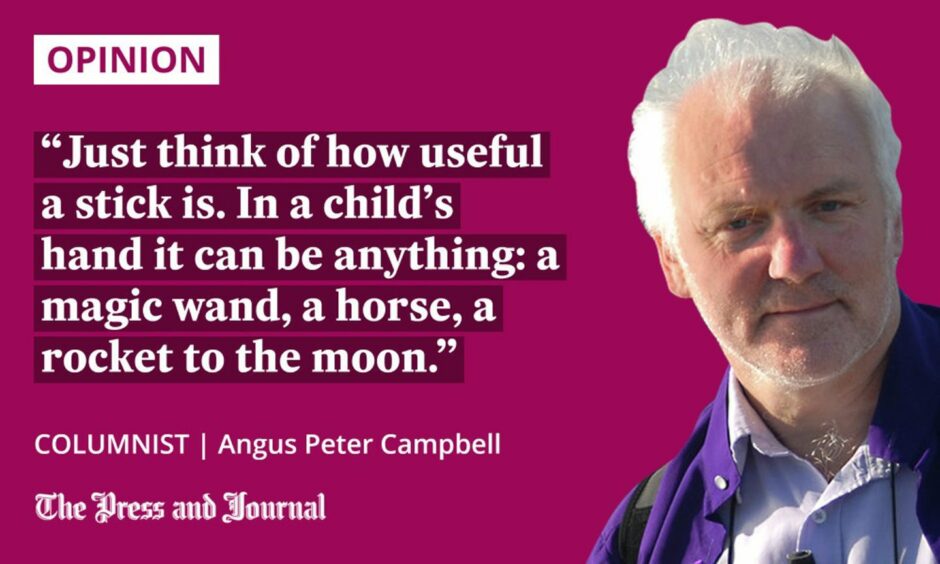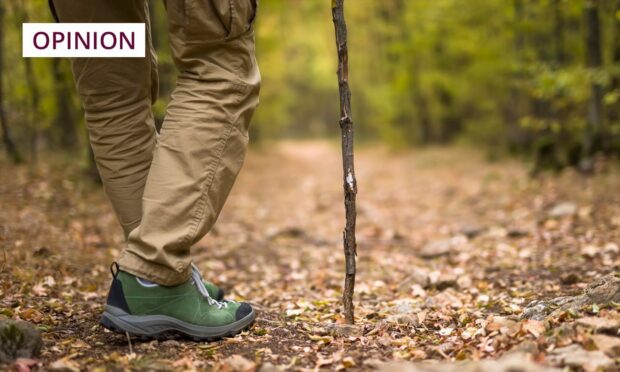I’ve taken to walking with a stick. Sometimes. Not because I really need it, but because I like it. It gives me rhythm and tempo.
The stick acts like a half-beat in music. I walk in musical four-four time, apparently: left foot, right foot, left foot, stick. Crochet, crochet, crochet, crochet as Beethoven would put it! I whistle, meantime, in semiquavers.
Maybe the stick is a substitute for a dog, because it’s good to have a companion as you walk. Some years ago I walked with my good friend Cailean MacLean from the Butt of Lewis to Barra – a fortnight’s walking through some of the places I love most in the world. We walked north to south because the prevailing wind from the North Pole would then be behind us. And so it was.
Harris was gorgeous: the sea to the west shimmering blue and green. Harris has two roads: the flat one that goes round the beautiful Atlantic coast, and the up-and-down one, called the Golden Road, that takes you through the rocky villages of the east down to Rodel and Leverburgh in the south. It’s actually a circular road, so if you are that way inclined you could walk round Harris forever and ever. Which sounds just about perfect to me.

We decided to cover it all: Cailean took the harder east road while I took the low road to the west. My boots echoing the silence, the stick tapping the road, thinking of Blind Pew.
Walking sticks do more than steady you
Walking sticks are more than music, however. They steady you as you walk. Give your hand a grip, as well as balance your body as you move. For if you don’t have a stick to hold, what on earth do you do with your hands?
It’s neither useful nor lovely to walk along with your hands in your pocket. That may be fine if you’re walking from the back of the room to the front to get a row from the teacher (“Hands out of your pockets, Campbell!”) but it hinders you greatly if you’re doing a 10 or 15-mile walk.
You can hold them by your side, or swing them as you walk along, except that any time I do that I immediately think I’m Calum Kennedy and start singing “Then swing along to a hiking song/ On the highway winding west…” before turning into Sir Harry Lauder and crooning “A far croonin’ is pullin’ me away/ As take I wi’ my cromack to the road…”
Ah! There it is – that great word ‘cromack’, a Scottified version of the Gaelic word ‘Cromag’, meaning crook. All good shepherds have crooks. My favourite shepherd, Andrew Glenn in the serial ‘Black Bob’, had a beautiful swan-shaped cromag, which we all imagined we had as children when we gathered the sheep, instead of the actual haphazard stick we really had.
Simple magic of a stick
A shepherd’s crook is a thing of beauty. It certainly meets William Morris’s definition of a proper object – something that is both useful and beautiful. If a thing is not useful it cannot be beautiful, and if a thing is not beautiful it cannot be useful.
A proper shepherd’s crook has three functions: to manage sheep; to defend against attacks by predators; and to help balance the shepherd on rough terrain. Often, they are also family heirlooms, handed down from generation to generation, each notch and mark reminding you of that time Grampa caught the big ram by the horn, pulling it from the bog, or the time Granma used it to chase the bogles away.
Crooks come in all shapes and sizes and can have horn, antler or wood handles. There are aluminium and metal ones, but let’s not spoil the world. The sticks themselves are traditionally made of ash or beech or chestnut or hawthorn or maple or hazel. Hazel has magic charms in the Celtic tradition – it protects against evil spirits and wards off rheumatism. Two very useful virtues.
Just think of how useful a stick is. In a child’s hand it can be anything: a magic wand, a horse, a rocket to the moon. Up on the screes of the Cuillin or the Cairngorms, a trekking pole in each hand can save many’s a slip and strain.
O, by the way, there is a thing called Harry Lauder’s Walking Stick, which – unfortunately – is not a walking stick at all, but a deciduous shrub known to gardeners by its official Latin name Corylus Avellana ‘Contorta’.
My own preference is not anything fancy or carved: I use what I find, which is currently a perfectly tapered stick of hazel found in the wood, just the right height, with a rest for my thumb at the top. With Sir Harry, off we go, as step I wi’ my cromag to the Isles.
Angus Peter Campbell is an award-winning writer and actor from South Uist


Conversation